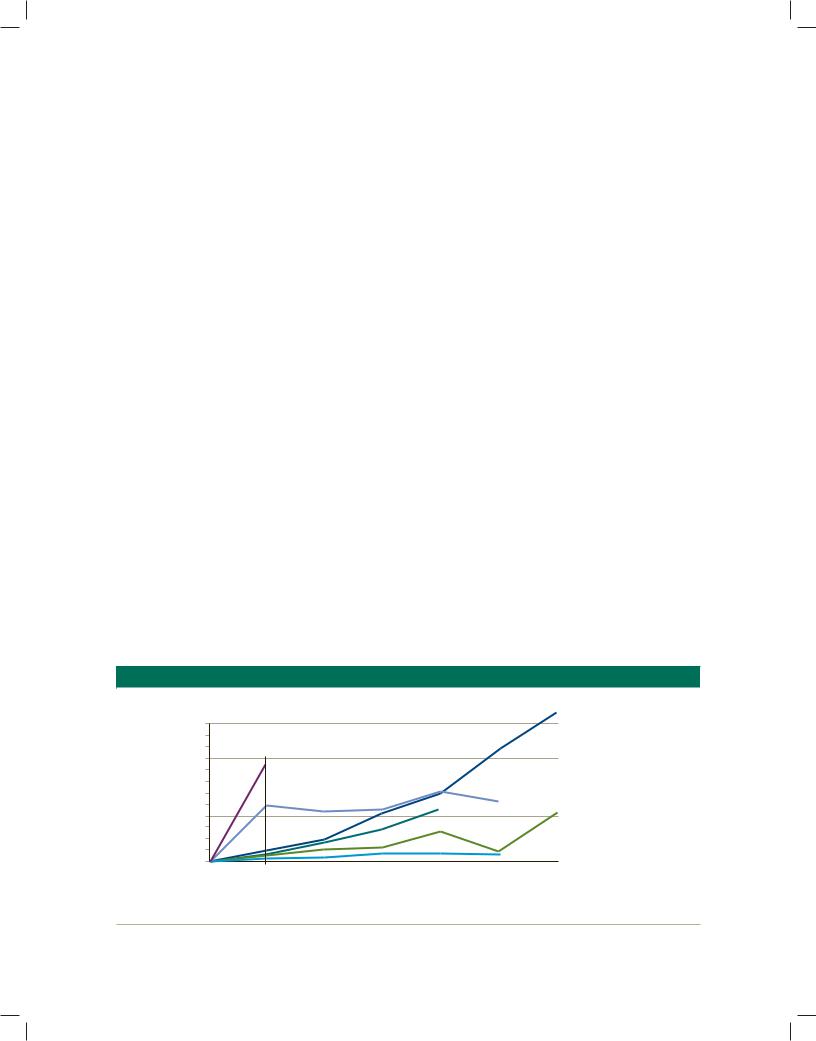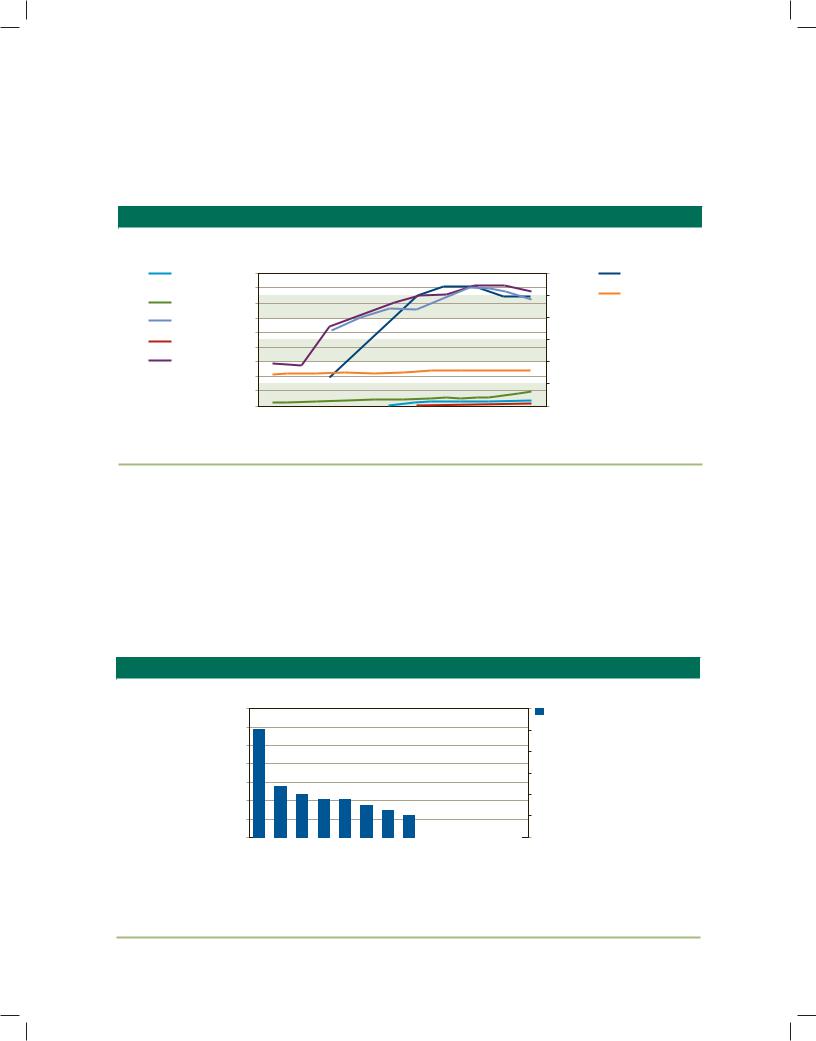
учебный год 2023 / De La Campa, Downes, Hennig, Making Security Interests Public. Registration Mechanisms in 35 Jurisdictions
.pdf
ELECTRONIC SYSTEMS
Vanuatu
Vanuatu shows how well an electronic registration system can work. The Personal Property Securities Registry, started in 2009, was created by the Financial Services Commission. The system is completely computerized and does not accept paper-based registration forms.14 Searches are also available online and may be performed by simply entering the name of the debtor, the registration ID number, or the asset’s serial number in the search section of the website. Searches are free of charge.
To perform a registration, registrants must simply provide their names, contact information, debtor names and addresses, secured party names and addresses, and collateral description, which could be general or specific.
New Zealand
The Personal Property Securities Register (PPSR) was created in 200215 and is under the Ministry of Economic Development. The registry is electronic,
accepting only online registrations. Searches can also be performed online at minimum cost.
To register a notice of security interest, secured creditors need to create a secured identification number. After this number is created, access is provided to a registrant’s user (such as loan officers), who can register notices of security interests and accrue transaction
fees to accounts. A notice shall contain information on a security interest expiration date if the financing statement is to be registered for less than five years,16 the debtor, collateral, and secured party details.
14The Republic of Vanuatu Personal Property Securities Registry is available at http://www.ppsr.vu/index.aspx.
15http://www.ppsr.govt.nz.
16
PAPER-BASED SYSTEMS
Albania
Albanian’s Central Collateral Registry, started in 2001, was established by the Secured Transactions Law. This law applies to all real rights on intangible property
or tangible property, whether present or future, that secures one or more obligations arising before or after the securing agreement.
The registry has an electronic database, but online registration is unavailable. A security holder or their representative submits an application for registration to the registry office. The application form must include details such as registration duration, debtor’s and secured party’s information, serial number of the
goods or description of other collateral that do not have a serial number, and registering person’s information. The submission of the form does not require the attachment of any original documents. Registry staff enter the information from the application form into the system, and a receipt (certificate of registration) is sent showing the full entry of the data to the registrant, the security holder, and debtor.17 Due to cost requirements, operation of the registry was privatized in 2009. That has created some uncertainty about ownership of the database and control over the registration function.18
Bulgaria
In Bulgaria a registrant must present an application for registration on paper, along with proof of payment of a stamp duty and signature of the creditor. Once
a registration form is accepted, the basic data are transferred to a database and the original forms with more detailed information scanned and attached to the registration record. The paper entry is valid for five years and can be renewed for five more years. Without a renewal, the registry software automatically considers the registration record inactive.
17 ! 1999.
18Baranes, Yair. 2010. “Establishing Modern Secured Financing Systems in Developing Economies.” FS Series 10. USAID, Washington D.C.
SECTION 2: FINDINGS & BEST PRACTICES |
9 |
|
|

The Central Collateral Registry, created in 1997,19 requires serial-numbered goods to be identified by serial number and vehicles by chassis number. But when
the collateral is a set of goods in turnover, a general description is sufficient. When entering an enterprise security interest, it is also enough to stipulate “security interest of the enterprise as a set of rights, obligations, and factual relations.” Furthermore, future assets can be described in general terms when initial entries are made. When they come into being, they must be described specifically in an amendment to the initial registration. In the case of future harvest, species production (wheat, rye, and the like), the amount of expected yield and location of planting are to be distinguished.
Completion of the registration form is usually conducted by the secured creditor. The application does not have to be notarized. Nevertheless, if registration
is requested by a person other than the debtor, the debtor’s consent is required in an official notarized form. Amendments to the Secured Transactions Law in 2008 provided for online registration and free electronic reports. But for various reasons (lack of financial resources, lack of adequately paid information technology specialists, and general regulations), the registry is currently not able to provide this service.
Moreover, though the branches of the Collateral Registry have electronic interconnections, they do not have access to the centralized database and so are not allowed to make entries, perform searches, and issue certificates and reports. But at the central registry, any person can perform a search without further restrictions.
Former Yugoslav Republic of Macedonia
In FYR Macedonia the use of movable property as security is governed by the 2003 Law on Contractual Pledge (developed with World Bank support). The Registry of Pledges on Movable Property and Rights is part of a system of electronic registries combined in the Central Registry.
19 http://www.justice.government.bg/new/Pages/Registers/Default.aspx.
The Central Registry has a computerized database. Public access to all records is available to users at the registry for a fee. The registry’s main office is in Skopje and it has 31 offices across the country. Registration forms must include all details of parties and security interests, together with supporting documentation, such as notarized copies of the security agreement and loan agreement. In addition, the secured claim and
security interest must be exactly described in the security agreement and in the registration statement. A study by the European Bank for Reconstruction and Development (EBRD) stated that economies which require copies of the security agreement or the agreement establishing the underlying secured claim add a considerable burden to the registration process. This is especially a problem due to the tendency in certain regions to include unnecessary information in such agreements. This is the case in Bulgaria, FYR Macedonia, and Romania.20
HYBRID SYSTEM
Guatemala
Guatemala has adopted the Organization of the American States Model Law on secured transactions. The registry in Guatemala was created in 2009.21 Online and paper registrations are accepted, but there is skepticism about how the registry operates—especially regarding registration costs.22 The fee to register a security interest is not flat. It is based on a complicated formula and may become quite onerous. The fee is equivalent to about USD19 plus 0.15 percent of the maximum amount of the obligation when the obligation exceeds USD1,118. That might partially explain why there were only 654 registrations in the Guatemala registry in 2009.
The basic information required for registration includes registrant’s contact information (if the registrant is not a party to the security agreement, evidence of authorization
20Publicity of security rights: setting standards for charges registries, European Bank for Reconstruction and Development (EBRD), January 2008.
21www.rgm.gob.gt
22National Law Center for Inter-American Free Trade (NLCIFT), Novedades, Volume 17, Number 3, September 2010.
10 |
MAKING SECURITY INTERESTS PUBLIC: REGISTRATION MECHANISMS IN 35 JURISDICTIONS |
|
|

by the secured party), debtor and secured creditor contact information, general or specific description of the collateral, and maximum amount of the obligation.
Once the information is entered into the database, the system automatically assigns a date and time of registration. Renewals and terminations can also be
performed through the electronic system. If the parties do not agree on other terms, registration will be valid for five years, renewable for another three years.
Finally, the system provides broad access of the database to the general public allowing for searches and issuing of a certificate with the data recorded by the registry. There is no need to justify the party’s interest in searching.
amount secured by the security interest, and a specific or general description of the collateral.
Registrations with the collateral registry generally lapse on expiration of the selected period or a statutory fixed period of registration. Registrations can be renewed before the expiration date. The registry generates a unique number for each registration so that it can be retrieved with certainty.
Survey results
Notice registries tend to provide a standard form for registration of a security interest in movable property whereas document registries, such as those in Bulgaria, Kosovo, and FYR Macedonia, might or might not provide a form in addition to requiring documents.
Registration among jurisdictions surveyed
International standards
Use of a standard form or online template is implicit in notice-based registrations that conform to global best practices.
In modern collateral registries the form usually contains the debtor’s name or numeric identifier, the debtor’s address, the name and address of the secured party, the
Jurisdictions that adhere to notice registration and global best practices have more registrations than do other jurisdictions of similar size and economic base. Many registrations translate into a significant number of loans granted by creditors. In nearly all cases, online registration is an option.
Even jurisdictions that require document registration might permit online registration in some cases. Spain, for example, introduced electronic registration system
Figure 1: Electronic databases increase the number of registrations and activities in East Europe and Central Asia
Percentage increase in registrations indexed to the first year of the registry’s existence
Romania 2001-07
|
First year |
|
|
|
|
|
|
of electronic |
|
|
|
|
|
||
1,000 |
registry |
|
|
|
|
|
|
Kosovo 2008-09 |
|
|
|
||||
|
|
|
|
||||
|
|
|
|
|
Bosnia and Herzegovina 2004-09 |
||
500 |
|
|
|
|
Serbia 2005-09 |
Albania 2001-07 |
|
|
|
|
|
|
|
||
100 |
|
|
|
|
|
Slovak Republic 2003-08 |
|
1 |
2 |
3 |
4 |
5 |
6 |
||
Year prior to |
|||||||
creation of registry |
|
Years since creation of the registry |
|
||||
Source: Doing Business 2011.
SECTION 2: FINDINGS & BEST PRACTICES |
11 |
|
|

Box 1: Amendments and Terminations
Countries with many registrations, such as New Zealand, Romania, and the United States, also had significant terminations and amendments—showing the great dynamism of such registries.
for movable collateral in 2002. But most registrants still submit paper registration because of burdensome documentation requirements, which makes the use of the online system as complex as a paper submission. As a result, fewer online registrations than expected
occurred between 2003 and 2009, and the cost borne by government to maintain this feature was extremely high relative to the small number of online registrations.
Number of registrations
There has been an increase in registrations in most jurisdictions with electronic databases (Figure 1).
Though the trend of registrations has risen, other factors may affect numbers in the short term. The global financial crisis of 2008-09 coincided with a dip in the number of registrations in more than 80 percent of responding jurisdictions. (See Annex 2 for more information). Though it is not certain that the financial crisis was the main cause of the decline, the variation across regions and registries suggests that there was some sort of influence on the number of registrations caused by the crisis in some regions.
The number of registrations is a function of many factors, including the functioning of the registry, the robustness of the legal framework, the level of economic activity in the jurisdiction, its population and size, banking practices and customs of lending institutions.
New Zealand has efficient registration and a strong legal framework. It has a modern law that covers all security devices that use movable property, provides for creation and attachment of security interests, sets a clear priority scheme, establishes the registry, and provides for swift enforcement. It also has a modern
collateral registry that covers all types of movable assets other than those covered by international conventions. It permits searching and registration exclusively online, has low fees that cover only the operational costs of the registry, and requires no documentation
in support of the registered notice. Such good features and efficient structure, among other factors, are reflected in the numbers of registrations. New Zealand is among the jurisdictions researched—one with the most registrations, having 649,188 registrations in 2005 and 418,938 registrations in 2009. Nevertheless the New Zealand and Canadian registries include liens on vehicles whereas US registries, for example, do not. Further, the China registry surveyed only includes security interests related to receivables. These factors need to be borne in mind when analyzing the underlying data. A meaningful comparison can only be made when taking into account these factors and comparing economies of the same size.
Registration costs
International standards
According to global practices, registration fees23 should be limited to the level required to cover the costs of operating the registry.24
When fixing flat fees, it is necessary to develop projections of the number of expected transactions and expected revenue. But doing so requires determining the business model adopted. For instance, the registry might share a platform with another service line (i.e. combining the website of the collateral registry with the company’s registry), having revenues from different sources.
Because most of the costs of operating an online notice registry are fixed, the volume of registrations is one important factor in determining the fee that must be charged to permit recovery of operating costs of the registry, though other factors may be taken into account by case.
23Registration fees should be assessed per notice, and should be set to recover only the costs of operation and capital replacement. (Secured Transactions Systems and Collateral Registries, 2010).
24See recommendation 54 (i) of the UNCITRAL Legislative Guide on Secured Transactions.
12 |
MAKING SECURITY INTERESTS PUBLIC: REGISTRATION MECHANISMS IN 35 JURISDICTIONS |
|
|

A large jurisdiction with a high volume of registrations will need less revenue per registration than a small one with fewer registrations. New Zealand, with 418,938
registrations in 2009, can charge USD2, while the Solomon Islands, with 6,439 registrations, needs to charge USD27. Both have similar fixed costs, with fully electronic registries. But New Zealand has a population of 4.3 million people while the Solomon Islands have about 0.5 million and
less economic activity. So New Zealand can charge less to maintain the registry.
Costs of operation of a document registry include many variables other than fixed costs. These include the cost of receiving, handling, and archiving documents, as well as the salaries and training of staff which examine the documents. Costs of operation increase based on the number of registrations and projections.
One additional cost associated with the registration is the cost of preparation and delivery of the registration. This can be significant, for instance, where registries require documents such as the security agreement
or loan agreement to be notarized and delivered to the registry. Costs of preparation and presentation can essentially be eliminated by providing for online registration or by simplifying the registration process when on paper or by fax.
Survey results
Among jurisdictions that charge for registration, more than 60 percent use a flat fee. Jurisdictions with flat fees for registration include Albania, Kosovo, and Vanuatu.
Some jurisdictions with notice registries do not charge flat fees, but treat fees more like taxes on transactions based on secured obligations. Fees can be prohibitive, depending on the amount secured.
Other jurisdictions have gradual fee structures that vary by various factors. Serbia bases registration fees on the amount of secured obligations and number of items of collateral. In Bosnia and Herzegovina the fee for registration depends on the duration of the security interest, the number of debtors and secured parties,
and whether the collateral consists of general property or special properties. In Bosnia and Herzegovina and Serbia the fees are reasonable and seem not to have affected registrations.
In Canada registration fees are set at the provincial level. Still, in all provinces, they are calculated based
on the duration of the registration. In British Columbia, for instance, the registration fee is about USD5 per
year of registration, up to 25 years. In Nova Scotia the registration fee is about USD31 per year of registration.
Registration fees in the United States are also different among states, but the average is about USD10. Because registrations have a fixed duration of five years, there is not much variability, but in some cases variations may occur. In Texas, electronic registration costs USD5; and for paper-based, USD15 for registration up to two pages, and USD30 for three or more pages. Texas had 289,000 registrations in 2007, indicating that the fees are not a significant barrier to registration.
In Senegal, on the other hand, the fee structure seems to be a barrier, as suggested by the low volume of registrations. The registration fee is a percentage of the secured debt that may vary from 1% to 5%. The low number of 1,492 new registrations in 2009 appears to be at least partially attributable to the substantial cost to users of the fees, though the fact that the collateral registry is a paper-based registry may also contribute to the low level of usage.
Centralized registry information
The record of the registry should be centralized and contain all registrations with respect to security interests registered.25 This means that the most efficient registry system will be the one that centralizes information
25See recommendation 54 (e) of the UNCITRAL Legislative Guide on Secured Transactions and Article 44 of the OAS Model Law on Secured Transactions.
SECTION 2: FINDINGS & BEST PRACTICES |
13 |
|
|

in one place for security interests of different types of collateral and transactions, from different locations and geographical areas and different types of debtors including both individuals and businesses.
By types of assets for which notices of security interest are registered
International standards
A registry structure that is fragmented by type of asset with no centralized database linking them together prevents potential lenders or buyers from relying on a single search when the searcher is interested in more than one type of asset. However, there are some types of assets for which there are legitimate arguments for separate registries. Where there are functional and transparent registries for security interests in major classes of property (e.g. motor vehicles or securities) when a reform is done, it is often less complex and more easily accepted if those classes are carved out and the existing registeries are allowed to continue operating.
Motor vehicles are, in many jurisdictions, registered in a separate registry, usually under the control of the Traffic Department or equivalent body. Security interests in aircraft, ships, investment securities and intellectual property are also, due to their specificity and relevent special laws or protocols to international conventions, often registered in separate or special registries.
Survey results
Survey results show that whereas some jurisdictions have fragmented registration systems, with different types of collateral registries for different types of assets (such as separate registries for registrations of security interests in accounts receivable, machinery, vehicles and intellectual property), others have a single collateral registry that accepts registrations of security interests for all or almost all types of assets.
Of the jurisdictions surveyed, one-third permit registration of interests in all or nearly all types of assets. New Zealand, Romania, and Canada are among them.
Registrations of security interests over all present and future assets, when allowed in the specific jurisdiction, are also commonly registered.
China is a classic case of disunity in a registration system. There, registration of security interests in accounts receivable is done at the Credit Reference Center, which is a unit of the People’s Bank of China. Interests in other movable assets (except for vehicles, aircraft and ocean-going vessels) are registered in separate and unlinked registries of the Administration of Industry and Commerce at one of four levels of government, the choice of which depends on a number of arcane factors. The result is that searching (except for security interests in receivables) is very difficult and unreliable to the extent that it is virtually never done.
By geographical coverage of collateral registry
International standards
By definition, movable property may be moved from one location to another, including a sale from the owner to a person in a different locale. In order to ensure
that a search of the collateral registry includes security interests in all property, regardless of whether it has been moved or sold to a different location, the registry should be geographically unified; that is, there should be one database that includes registrations of security interest for the whole jurisdiction. That may be done either with a single registry office for the jurisdiction or through an electronic database that aggregates input from remote branches.
Survey results
Of the jurisdictions surveyed, a vast majority have an electronic system with a single database for the entire jurisdiction. In some jurisdictions such as the United States and Canada, however, the registries are centralized at the state and provincial level — not ideal, but a vast improvement over the earlier countylevel registry approach used in the United States under the earlier version of its uniform law. In the
14 |
MAKING SECURITY INTERESTS PUBLIC: REGISTRATION MECHANISMS IN 35 JURISDICTIONS |
|
|

United States, the common justification of location of registries at the state, rather than the federal level is that states are sovereign entities and that the federal government has not pre-empted this body of law. Also, in the United States and Canada, the problem of decentralization of registries is mitigated through the compilation of the information by private companies which sell multi-state searches to potential secured creditors and buyers of movables.
By types of debtors and types of legal interests
International standards
A collateral registry should permit registration of notice of a security interest by any type of debtor without respect to the particular form of legal interest. Potential lenders or buyers should be able to rely on a single search to find all security interests that identify a debtor, independently of the debtor’s legal structure (e.g. natural persons or juridical persons) or the particular form of the secured party’s legal interest in the collateral (e.g. chattel mortgage, charge, non-possessory pledge, retained title, etc.).
The most common case of fragmentation according to debtor type happens in the jurisdictions that adopted the traditional common law system wherein security interests in movable collateral of incorporated companies are registered in the Companies Registry, and security interests of unincorporated debtors are either registered in a different registry (e.g. Bill of Sale Registry) or are not registered at all.
According to international best practices, a unified database should exist with complete information relating to any registration effected against the movable property of a debtor regardless if the debtor is a juridical person or a natural person or of the legal form of the security interest. They all should be registered in the general collateral registry. Best practices, furthermore, call for inclusion in the registry of notice of some other type of guarantees that might not be considered security interests because of their legal form. These other types of guarantees, if not published
through registration, might not be apparent to a third party. Such interests include long-term operating leases and the sale of accounts receivable and secured sales contracts.
Survey results
Among the jurisdictions surveyed, about one-third provide for registration of security interests in the movable assets of incorporated debtors in their Companies Registries, including Hong Kong SAR China, Ireland, and Malaysia. In many of these cases, lenders to unincorporated enterprises and individuals have no adequate means of assuring their priority in movable assets due to a lack of a specific registry for security interests granted by them.
In some surveyed jurisdictions, registration of security interests is fragmented according to the legal form of the transaction. That is, they have different publicity rules for different legal mechanisms that secure an obligation (pledge, sale with retained
title, enterprise mortgage, etc.). In some other jurisdictions, some legal interests in movable assets are publicized by registration, while other types are not. This is the case of Finland where only security interests over the enterprise are publicized (in the enterprise mortgage registry). In other cases, some types of legal interest in movables are registered (e.g. non-possessory pledges or chattel mortgages), while other types are not registered (e.g. different forms of sale with retained title). This is the case of economies such as Bangladesh and Jamaica.
The search process
International standards
Information in the collateral registry should be accessible to the public, whether directly or through registry staff. Ideally, the registry database should be accessible from any location, including outside the jurisdiction, by users who have internet access and
SECTION 2: FINDINGS & BEST PRACTICES |
15 |
|
|

through access points for individuals who do not have their own means of access to the internet.26
The registry system should be designed to permit the database to be searched according to the debtor’s
identity (e.g. complete name or national identification number) or by the registration number assigned by the registry to each registration. Some jurisdictions also provide for indexing and searching for registrations
of security interest by serial numbered assets (such as vehicles, agricultural or industrial equipment).
The most efficient system would allow for searches based on any of the three criteria mentioned.
The most common and most important search criterion is the identity of the debtor. The options for searching by debtor are the debtor’s name or a unique numeric identifier. Though either of these
options is viable, a unique numeric identifier is a more precise search criterion than a name, provided that the numeric identifier is unique, permanent and publicly available.27 Different options may be used in the
same system for different types of debtors, since some types of debtors may have a viable numeric identifier, while others do not. For example, citizens may have a national identification number on which searches may be done, while registered legal entities may not have a permanent registration number, so must be searched according to name.
The critical factor to a successful search process is to have clear and objective rules that can be applied by an IT system without registry staff intervention to produce absolutely predictable results. Those rules must be published so that searchers know how to search and can rely on the results in every case. The search rules generally call for identifying only exact matches for debtor types that have a unique numeric identifier. Where names must be used, the rules generally provide for searching on
26See Articles 45 and 46 of the OAS Model Law on Secured Transactions.
27See recommendation 54 (h) of the UNCITRAL Legislative Guide on Secured Transactions.
a normalized version of the name. Normalization rules may include steps such as removal of case differences, removal of punctuation and diacriticals, concatenation of free-standing characters, removal of words or abbreviations that indicate the type
of legal enterprise, and compression of remaining words into a character string. Searches by name often will produce results that include registrations for more than the targeted debtor, but they will always produce all registrations that include the correct debtor name. Where more than the targeted registrations are returned, the searcher must use other data in the registered notices (such as address or birth date) to eliminate the excess results.
Still regarding the searching process, it should either be free of charge, or fees should be kept to a minimum level to help cover the maintenance of the electronic platform. Excessive fees for searches will significantly deter utilization of the registry.
Survey results
The survey results show an increase in the volume of searches in the majority of the jurisdictions with an electronic database capable of centralizing the information (Figure 2). The volume is also much higher in jurisdictions that count with an electronic database than in those without it. This might imply that potential lenders rely more on such systems for searching since they usually count with much more precise information.
Another interesting aspect regarding the number of searches is the ratio of the number of searches to the number of new registrations. Where there is rough parity in those numbers, it is an indication that users value the registry as a risk management and prudent lending tool to assure priority. It means they are searching before making lending decisions and registering. Where the ratio is low, it is an indication that users register only because it is part of a process. They do not search before making decisions and take more risks than creditors that use the search
16 |
MAKING SECURITY INTERESTS PUBLIC: REGISTRATION MECHANISMS IN 35 JURISDICTIONS |
|
|

Figure 2: Registries with electronic database equal high volume of searches
Volume of searches
Bosnia and |
450,000 |
|
|
|
|
|
|
|
|
|
Herzegovina |
400,000 |
|
|
|
|
|
|
|
|
|
Bulgaria |
350,000 |
|
|
|
|
|
|
|
|
|
Ireland |
300,000 |
|
|
|
|
|
|
|
|
|
|
|
|
|
|
|
|
|
|
|
|
Serbia |
250,000 |
|
|
|
|
|
|
|
|
|
200,000 |
|
|
|
|
|
|
|
|
|
|
|
|
|
|
|
|
|
|
|
|
|
U.S. (Texas) |
150,000 |
|
|
|
|
|
|
|
|
|
|
100,000 |
|
|
|
|
|
|
|
|
|
|
50,000 |
|
|
|
|
|
|
|
|
|
|
0 |
|
|
|
|
|
|
|
|
|
|
2000 |
2001 |
2002 |
2003 |
2004 |
2005 |
2006 |
2007 |
2008 |
2009 |
Source: Collateral Registry surveys.
3,000,000 |
New Zealand |
2,500,000 |
Canada |
|
(British Columbia) |
2,000,000
1,500,000
1,000,000
500,000
0
This scale applies to
New Zealand and Canada
function as a prudent lending technique. Jurisdictions such as New Zealand (almost 6 times more searches than registrations) and British Columbia, Canada (almost 3 times more searches than registrations) present a high ratio of searches to registrations, which means the registry is being used as a risk management mechanism (i.e., to determine if there are prior encumbrances of prospective collateral).
In jurisdictions such as Albania and Kosovo, there are significantly fewer searches than registrations, implying that the registry is not considered an important factor in lending decisions (Figure 3).
Most of the surveyed jurisdictions keep the search costs quite reasonable or free, at least for searches done online by users. New Zealand’s registry, for instance,
Figure 3: Ratios of searches to registrations
Higher ratio indicates registry is used as risk management mechanism
7
6
5
4
3
2
1
0
|
|
|
|
|
|
|
|
|
|
|
|
|
|
|
|
|
|
|
|
|
|
|
|
|
|
|
|
|
|
|
|
|
|
|
|
|
|
|
|
|
|
|
|
|
|
|
|
|
|
|
|
|
|
|
|
|
|
|
|
|
|
|
|
|
|
|
|
|
|
|
|
|
|
|
|
|
|
|
|
|
|
|
|
|
|
|
|
|
|
|
|
|
|
|
|
|
|
New Zealand |
|
Canada (British Columbia) |
|
|
Macedonia, FYR |
|
|
Vanuatu |
|
|
U.S (Texas) |
|
|
China (CRC only) |
|
Bosnia & Herzegovina |
|
|
Bulgaria |
|
Canada (Nova Scotia) |
|
|
Solomon Islands |
|
|
|
Albania |
|
|
|
Serbia |
|
|
|
Kosovo |
||||||||||||
Source: Collateral Registry surveys.
Ratio searches/ registration (2009)
SECTION 2: FINDINGS & BEST PRACTICES |
17 |
|
|

charges a fee of only USD0.70 per search and Ireland’s registry also has a reasonable fee varying from USD3.40 to USD4.80 per search. In the Solomon Islands and Vanuatu searches are free of charge.
Summary of the main features of a modern collateral registry
As illustrated in this paper, registries should provide for efficient registration and searching (online searches and payments, instant registration, etc.), and be cost
effective to users and governments. The main features that are considered as best practices were selected and compared with the reality of the institutions surveyed. The table below (Table 2) shows which features these are and the following table (Table 3) shows how the surveyed registries conformed or failed to conform to the following best practices.
Table 2: Main features of an efficient movable collateral registry
Feature |
Description |
|
1. Notice based system |
No documents need to be submitted, and the registry does not verify the legality of the transaction. |
|
2. |
Electronic database |
No paper archive. |
3. |
Online system for registrations, |
Functioning 24/7 (except for system updates) and no restrictions on who can do registrations and |
|
amendments, renewals, |
searches. |
|
cancellations and searching |
|
4.Indexing and searching according Searchers may search by a unique debtor ID number or debtor name, by a registration number or by a to debtor identity, registration serial number if looking for serial-numbered collateral.
number and serial number
5. Centralized registry |
All information is available in one single database for the whole jurisdiction, regardless of the type of |
|
asset, type of debtor, type of security interest mechanism used to create the collateral. If a jurisdiction |
|
has different branches of the registry, such branches must be linked into one database. |
6.All types of assets accepted for The law governing registration should not exclude any types of movable assets from registration. registration
7.Reasonable fees for registrations The registry charges a reasonable flat fee (to cover the costs administering the registry only) for
and searches |
registrations and for searches (charging for searches is optional). |
8. Registration done by secured |
Secured creditor or its representative is responsible for registering. No restrictions on who can file. |
creditors or their representatives |
|
9. Liability |
The registrar is liable only for errors caused by malfunction or unavailability of the registry system. |
10. Limited discretion |
The registrar should not be in charge of verifying information and rejecting or accepting applications, |
|
unless mandatory information is missing. |
|
|
18 |
MAKING SECURITY INTERESTS PUBLIC: REGISTRATION MECHANISMS IN 35 JURISDICTIONS |
|
|
